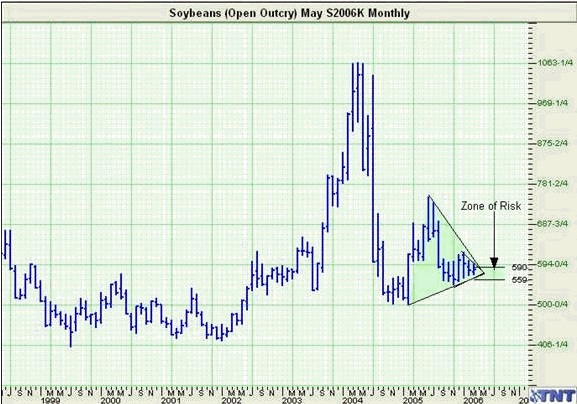Trade Description
Buy three May Soybean 570 puts and sell one May Soybean 590 put for a cost of approximately $100 prior to the close on March 30th, 2006. Options expire on Friday, April 21st, 2006. Margin is roughly $600, but can fluctuate depending on market price in relation to time value and volatility.
Explanation
After a significant â�,�˜flatâ�,��"� period in soybeans we head into a critical prospective plantings report that offers the potential to be devastating to the soybean market. Projections for huge planting numbers are setting up a possible selloff following the Friday morning reports. This ratio spread design plays on three key elements:
- Volatility: this critical report is likely to break this market out of its current sideways consolidation pattern and the trade design removes the majority of risk as long as the market is outside of 5.90 to the upside or 5.59 to the downside.
- Discounted put premiums: This same ratio would cost approximately $200 more to do the identical design on the call side. Taking advantage of discounted out of the money put premiums will provide a greater benefit should the volatility expand to the downside.
- Defined risk, max margin and cost with nearly unlimited profit potential and leverage: This trade design is a breakout to the downside spread that gives you the equivalent of 2 short positions below 5.59 and a defined max risk of $1,000 plus cost of trade (although max risk is nearly impossible to achieve as the market would have to be at exactly 5.70 at expiration without having exited any part of the spread).

Profit Scenarios
Max profit at expiration is nearly unlimited and is $100 per cent below 5.59 (assuming a $100 entry cost).
Risk Scenarios
Max risk is $1,100 (assuming entry cost is $100) and occurs at expiration with the market at exactly 5.70. Loss is reduced by $50 per cent above 5.70 up to 5.90, whereas loss is the cost of the trade at expiration with the market above 5.90 ($100). Loss is reduced by $100 per cent below 5.70 to 5.59 which is the downside breakeven at expiration. Time value and volatility are the key elements in this trade. If the market is near 5.70 within a few days to expiration the 5.70 puts will have a reasonable amount of premium in them and thus allow for a reduced exit or potentially profit exit prior to expiration.
James Mound is the head analyst for www.MoundReport.com, and author of the commodity book 7 Secrets. For a free email subscription to James Mound's Weekend Commodities Review and Trade of the Month, click here.
Disclaimer
There is risk of loss in all commodities trading. Commissions and fees vary per individual and therefore are not included in profit, cost and risk scenarios. Please consult a licensed broker before you trade for the first time. Losses can exceed your account size and/or margin requirements. Commodities trading can be extremely risky and is not for everyone. Some option strategies have unlimited risk. Educate yourself on the risks and rewards of such investing prior to trading. James Mound Trading Group, or anyone associated with JMTG or moundreport.com, do not guarantee profits or pre-determined loss points, and are not held monetarily responsible for the trading losses of others (clients or otherwise). Past results are by no means indicative of potential future returns.